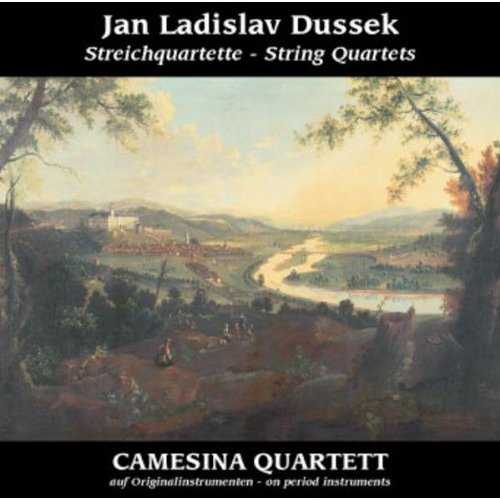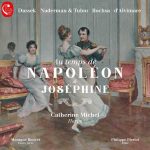
Composer: Jan Ladislav Dussek
Performer: Camesina Quartett
Audio CD
SPARS Code: DDD
Number of Discs: 1
Format: FLAC (image+cue)
Label: Avi
Size: 382 MB
Recovery: +3%
Scan: yes
01. Dussek, Jan Ladislav: String quartet in G op. 60 No 1 – Allegro grazioso
02. Dussek, Jan Ladislav: String quartet in G op. 60 No 1 – Larghetto non troppo lento
03. Dussek, Jan Ladislav: String quartet in G op. 60 No 1 – Rondo: Tempo di Polacca quasi Andante
04. Dussek, Jan Ladislav: String quartet in B Flat op. 60 No 2 – Allegretto
05. Dussek, Jan Ladislav: String quartet in B Flat op. 60 No 2 – Adagio pathetico
06. Dussek, Jan Ladislav: String quartet in B Flat op. 60 No 2 – Menuetto: non presto e semplice
07. Dussek. Jan Ladislav: String quartet in B Flat op. 60 No 2 – Finale: Allegro non troppo
08. Dussek, Jan Ladislav: String quartet in E Flat op. 60 No 3 – Allegro espressivo
09. Dussek, Jan Ladislav: String quartet in E Flat op. 60 No 3 – Adagio non tanto
10. Dussek, Jan Ladislav: String quartet in E Flat op. 60 No 3 – Menuetto: Scherzo, con moto assai
11. Dussek, Jan Ladislav: String quartet in E Flat op. 60 No 3 – Finale: Allegro moderato
Chamber music with intellect, heart and soul
This review has been postponed for over a year since my first hearing of these works. The reason being the need for musical gestation and to do justice to some very wonderful and sublime music that has curiously again, been forgotten with time.
That the music continues to be neglected is shown from the lack of reviews (since it is still empty after a year, I gather I should have the honour to amply fill up the void?)
Hence one might be inclined to ask – is Dussek really so obscure a composer?
That he is in the present day is quite a given. Most conscientious classical listeners would have had a glance or two at his name when researching through literature, often through some association with his contemporary, Beethoven. Yet contrary to some misleading sources from an online community encyclopedia, Dussek was a well-known and respected musician and virtuoso pianist in both England and Continental Europe during his lifetime. His works continued to be played during the Romantic age, even when his style had largely been integrated by later generations of pianists.
I have written about Dussek’s music in some of my earlier reviews. That I have not written more is for the fact that the listener needs on his or her own to uncover the music of this wonderful composer, a composer certainly not devoid of genius in his best works.
Fortunately too, Dussek’s music is gradually being rediscovered in the last decade or two by eminent fortepianists like Andrea Staier and Malcom Bilson. The wonderful sonority of his piano sonatas on the modern grand has also been wonderfully recorded by Marcus Becker and other pianists (Dussek was afterall, instrumental to the development of the modern grand by requesting Broadwood to extend the compass of the existing pianoforte in the late 1790s/early 1800s).
While Dussek was, like Chopin, primarily known for his historical importance in the development of the piano and its music, Dussek went further to embrace a number of other forms. The string quartets in this disc hold a very strong case for his efforts.
String quartets, after symphonies, form the cornerstone of erudite classical music creation, exemplified by the triumvirate of the Viennese masters, Haydn, Mozart and Beethoven. The classical form could adequately be said to be expanded and developed to its fullest potential with Beethoven, who stretched the limits of form and tonality itself with his last works.
It is hence, unsurprising that given the monumental achievements of Beethoven’s string quartets, the works of his contemporaries were eclipsed.
Yet if we ignore these three quartets, we are missing a truly unique voice.
Dussek was a quintessentially evocative composer. He was born in a classical age, but he added a dimension to it through the imaginative use of harmonic colours that gave his music a unique sense of transcendence and sensuality, a Gothic ambience that was essentially proto-Romantic.
The three quartets are exemplary extensions of this aesthetic ideal (most brilliantly expressed in his piano works) – an ideal not even his contemporary Beethoven was always able to evoke fluently and comfortably (who, through his ideal of formal perfection, was at pains to ensure other considerations be purposefully subsumed under form and structure, never at the expense of it).
Dussek’s quartets never sound thin or flippant, always giving the listener a sense of satisfaction that the ear expects from the form. Competently and imaginatively crafted, they offer a balanced approach to this form through three or four movements, each with a unique character, mood and feel.
Of note in the first of the three quartets, the Quartet in G major, is an enchanting Rondo in the manner and tempo of a Polacca, a national music genre which Dussek was most comfortable and at home in. The pulsating rhythm is lively, mildly energetic, slightly quizzical and almost tongue-in-cheek, but always evocative, graceful and never irreverent.
Perhaps the most notable, sublime and well-crafted movement would be the Adagio pathetico from String Quartet in B Flat op. 60. Perfection unto itself, the music seems like it had written on its own. Beginning from where it seemed to have ended, the main theme announces the motif of a repeated dotted rhythm figure with an interval of a second (reminiscent of the 1st movement of Mozart’s 40th Symphony, albeit in the major mode). Next, the viola echoes the first and the second reprise with haunting effect. The tutti builds, with repeated chords, to a climax that traverses some very evocative harmonies, before coming to a cadence that leads to individual instrument voices (from the ascending order of the cello, viola, second violin and finally the first violin) showcasing a melodic line that is a variation of the main theme in different keys (variants of major and minor), depicting the vacillation and ambiguity of moods. The entire beauty of this movement palpitates on the genius of the flow. Each idea glides through another effortlessly, extending ad infinitum, never exhausting itself as they grow collectively from one another in successive voices. The overall effect is unbearably poignant yet yieldingly peaceful. The sublime achievement of this movement is how the paradoxes (presented in the tormenting and anguished development) were eventually melded and resolved as one (in the key of B flat major) through the development of an undulating ‘ascending and falling’ motif. The listener is transported through a journey of catharsis and purification – the beginning as the end and the end as the beginning.
While the other movements do not attain such heights of sublimity, they are delightful in their own merits, often with a tinge of melancholy. The succeeding Quartet in E flat is an example; offering an impassioned Allegro Expressivo, a gentile and nostalgic adagio (after the cathartic emancipation of the previous quartet), an equivocal minuetto (that was to be used as the third movement of his great Piano Sonata in A flat dubbed `Le Retour de Paris’ or `Plus Ultra’) and a vivacious finale to end of in good spirits, a very admirable gem of a string quartet cycle.
The credit goes to the Camesina Quartet; their conviction of the value of these works (as far as to record and to produce them), the sympathetic rendering and delicacy of the period strings, without which no justice could be done to these admirable and well-crafted works.



